Related Research Articles

Fides was the goddess of trust and good faith in Roman paganism. She was one of the original virtues to be considered an actual religious divinity. Fides is everything that is required for "honour and credibility, from fidelity in marriage, to contractual arrangements, and the obligation soldiers owed to Rome." Fides also means reliability, "reliability between two parties, which is always reciprocal." and "bedrock of relations between people and their communities", and then it was turned into a Roman deity and from which we gain the English word, 'fidelity'.
LacusCurtius is a website specializing in ancient Rome, currently hosted on a server at the University of Chicago. It went online on August 26, 1997; in July 2021 it had "3707 webpages, 765 photos, 772 drawings & engravings, 120 plans, 139 maps." The site is the creation of William P. Thayer.

The Baths of Diocletian were public baths in ancient Rome. Named after emperor Diocletian and built from 298 CE to 306 CE, they were the largest of the imperial baths. The project was originally commissioned by Maximian upon his return to Rome in the autumn of 298 and was continued after his and Diocletian's abdication under Constantius, father of Constantine.
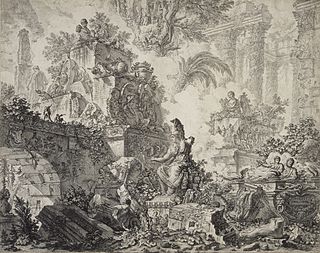
The Baths of Titus or Thermae Titi were public baths (Thermae) built in 81 AD at Rome, by Roman emperor Titus. The baths sat at the base of the Esquiline Hill, an area of parkland and luxury estates which had been taken over by Nero for his Golden House or Domus Aurea. Titus' baths were built in haste, possibly by converting an existing or partly built bathing complex belonging to the reviled Domus Aurea. They were not particularly extensive, and the much larger Baths of Trajan were built immediately adjacent to them at the start of the next century.
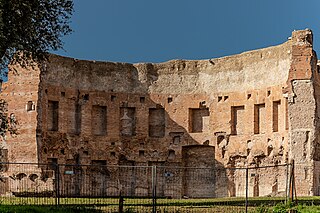
The Baths of Trajan were a massive thermae, a bathing and leisure complex, built in ancient Rome and dedicated under Trajan during the kalendae of July 109, shortly after the Aqua Traiana was dedicated.
A Topographical Dictionary of Ancient Rome is a reference work written by Samuel Ball Platner (1863–1921).
The first edition was published in 1904; the second edition was published in 1911 .
The book was completed by Thomas Ashby after Platner's death and published in 1929 by Oxford University Press. Referred to as 'Platner and Ashby', the volume describes the ancient monuments and buildings in the city of Rome, although by and large only if they belong to the classical period. It covers both remains that are still extant and buildings of which not a trace remained, and collates source documents for each. This volume was, for fifty or sixty years, the standard reference in the field of Roman topography, having superseded Rodolfo Lanciani's Forma Urbis Romae (1893‑1901).
Platner and Ashby has since itself been superseded by a reworking, L. Richardson, Jr.'s A New Topographical Dictionary of Ancient Rome, but mostly by the new standard, a completely new work, Margareta Steinby's Lexicon Topographicum Urbis Romae.

Samuel Ball Platner was an American classicist and archaeologist.

Christian Karl Friedrich Hülsen was a German architectural historian of the classical era who later changed to studying the Middle Ages and the Renaissance.

The Porticus Octaviae is an ancient structure in Rome. The colonnaded walks of the portico enclosed the temples of Jupiter Stator and Juno Regina, as well as a library. The structure was used as a fish market from the medieval period up to the end of 19th century.
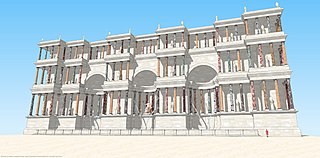
The Septizodium was a building in ancient Rome. It was built in 203 AD by Emperor Septimius Severus. The origin of the name "Septizodium" is from Septisolium, from the Latin for temple of seven suns, and was probably named for the seven planetary deities or for the fact that it was originally divided into seven parts. The building had no known practical purpose and was probably meant to be a decorative façade, known as a nymphaeum. Ancient and medieval sources describe its purpose as being to impress Severus' fellow north Africans as they entered the city, as it was located at the place where the Via Appia passes the Palatine and leads east towards the Forum Romanum. Other examples of septizodia are known, all from Africa.
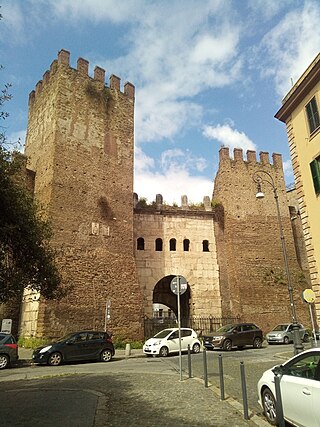
Porta Tiburtina or Porta San Lorenzo is a gate in the Aurelian Walls of Rome, Italy, through which the Via Tiburtina exits the city.
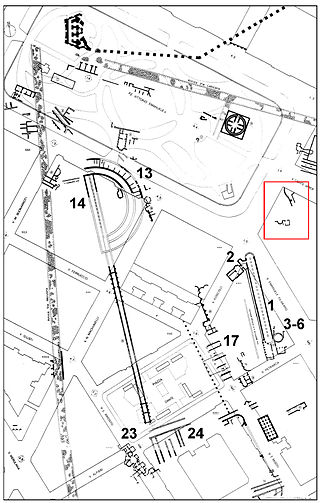
The Horti Lamiani was a luxurious complex consisting of an ancient Roman villa with large gardens and outdoor rooms. It was located on the Esquiline Hill in Rome, in the area around the present Piazza Vittorio Emanuele. The horti were created by the consul Lucius Aelius Lamia, a friend of Emperor Tiberius, and they soon became imperial property. They are of exceptional historical-topographical importance. Along with other ancient Roman horti on the Quirinal, Viminal and Esquiline hills, they were discovered during the construction work for the expansion of Rome at the end of 1800s.
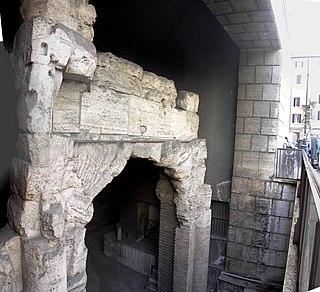
The Stadium of Domitian, also known as the Circus Agonalis, was located to the north of the Campus Martius in Rome, Italy. The Stadium was commissioned around AD 80 by Emperor Titus Flavius Domitianus as a gift to the people of Rome and was used almost entirely for athletic contests. In Christian tradition, Agnes of Rome was martyred there.

The Domus Transitoriatransl. House of Passage was Roman emperor Nero's first palace damaged or destroyed by the Great Fire of Rome in 64 AD, and then extended by his Domus Aurea.

In ancient Rome, the Piscina Publica was a public reservoir and swimming pool located in Regio XII. The region itself came to be called informally Piscina Publica from the landmark. The piscina was situated in the low-lying area between the Via Appia, the Servian Wall, and the northeast slope of the Aventine Hill, an area later occupied by the Baths of Caracalla.

The topography of ancient Rome is the description of the built environment of the city of ancient Rome. It is a multidisciplinary field of study that draws on archaeology, epigraphy, cartography and philology. The word 'topography' here has its older sense of a description of a place, now often considered to be local history, rather than its usual modern meaning, the study of landforms.

The Arch of Dolabella and Silanus or Arch of Dolabella is an ancient Roman arch. It was built by senatorial decree in 10 AD by the consuls P. Cornelius Dolabella and C. Junius Silanus.

The Baths of Nero or Baths of Alexander were a complex of ancient Roman baths on the Campus Martius in Rome, built by Nero in either 62 or 64 and rebuilt by Alexander Severus in 227 or 229. It stood between the Pantheon and the Stadium of Domitian and were listed among the most notable buildings in the city by Roman authors and became a much-frequented venue. These thermae were the second large public baths built in Rome, after the Baths of Agrippa, and it was probably the first "imperial-type" complex of baths, with a monumental scale and symmetrical, axially-planned design. While in the sixteenth century the foundations of the caldarium were still visible, nothing else of the structure remains above ground except some fragments of walls incorporated into the structure of Palazzo Madama.

The Baths of Decius were a thermae (baths) complex built on the Aventine Hill by the emperor Decius in 249 or 252. Its site was between the present-day sites of the churches of Santo Alessio and Santa Prisca, on the Vigna Torlonia, under piazza del Tempio di Diana and the Casale Maccharini Torlonia, which includes remains from the baths. Some other ruins of the baths also survive.
The Temple of Honor and Virtue was a temple in Regio I of ancient Rome dedicated to Virtus and Honos. No remains survive. It is the first entry for Regio I in the regional catalogues and was sited just outside the porta Capena, probably on the northern side of the via Appia. In front of it was the Ara Fortuna Redux.
References
- ↑ Historia Augusta, Commodus 17; Chron. 147; Hieron a. Abr. 2199; Chronicon Paschale I, 226; Herodian I, 12.4.
- 1 2 Samuel Ball Platner, A Topographical Dictionary of Ancient Rome , Oxford University Press, London, 1929 (completed and revised by Thomas Ashby), on: Bill Thayer's LacusCurtius.
- 1 2 Lodovico Antonio Muratori, Annali d'Italia del principio dell'era volgare sino all'ano 1750 , Giuntini, 1762, pag. 387.
- ↑ Scheda 243429, Census of Antique Works of Art and Architecture Known in the Renaissance, Berlin-Brandenburgische Akademie der Wissenschaften and Humboldt-Universität zu Berlin (accessed 26-03-2014).